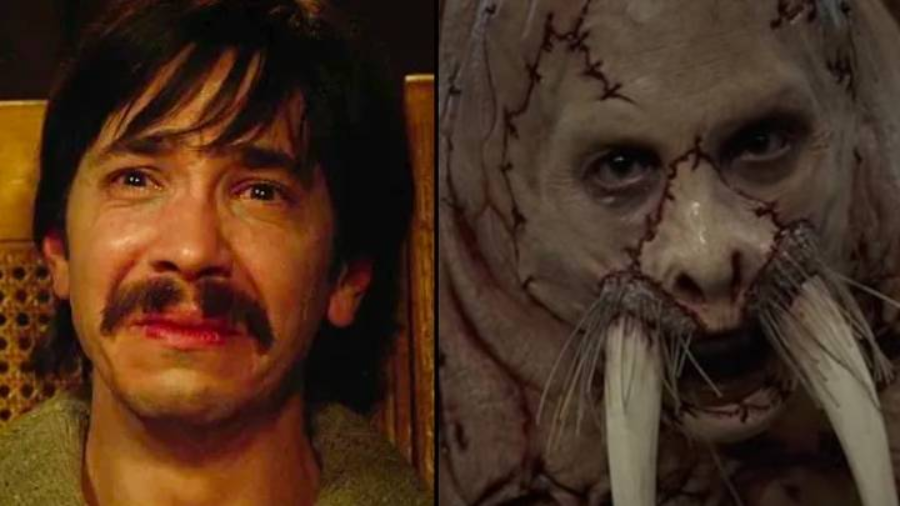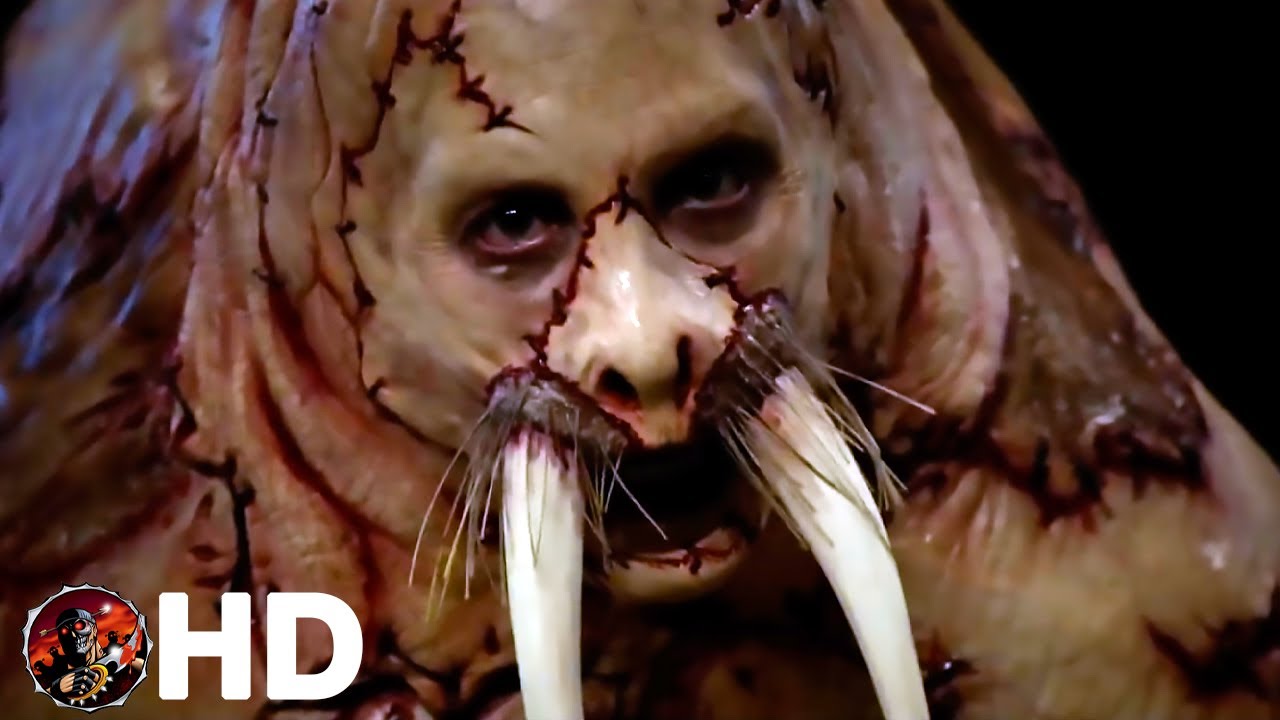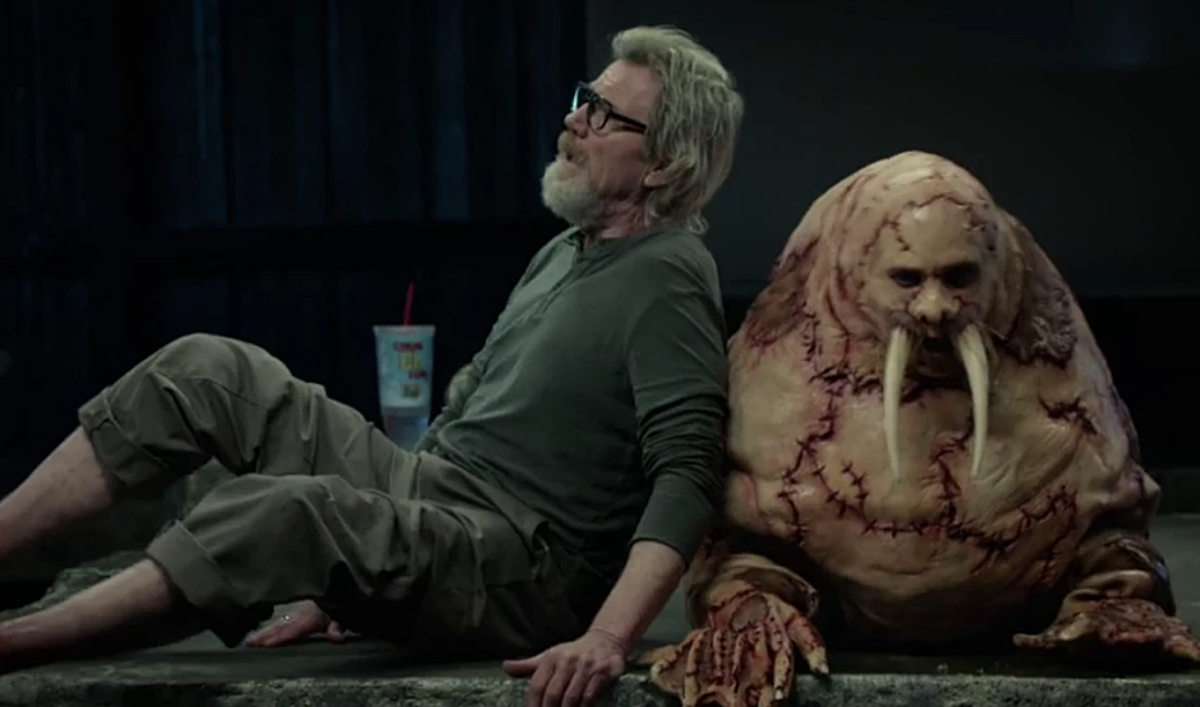Viewers Horrified After Watching Horror Film "Tusk" That's Worse Than The Human Centipede
Horror films have the unique ability to elicit intense emotions, from fear and shock to fascination and discomfort. Viewers horrified after watching horror film "Tusk" that's worse than The Human Centipede. The film's disturbing content has ignited discussions about its impact on audiences and the boundaries of cinematic horror.
Author:Morgan MaverickReviewer:Professor JhizAug 15, 20231K Shares47.9K Views

Horror films have the unique ability to elicit intense emotions, from fear and shock to fascination and discomfort. Many viewers horrified after watching horror film "Tusk" that's worse than The Human Centipede. The film's disturbing content has ignited discussions about its impact on audiences and the boundaries of cinematic horror.
The bizarre story of Tusk centers on Justin Long's character, a podcaster who encounters a mad scientist and is surgically transformed into a walrus. Fans have called the movie more frightening than The Human Centipede, whose 2011 sequel was banned in the UK, since it contains graphic sequences of bodily modification.
The reception of "Tusk" has been characterized by shock, disbelief, and even trauma among viewers. The film's unsettling premise, graphic scenes, and psychological horror elements have left some viewers deeply disturbed.
Social media platforms have been flooded with comments from individuals expressing their shock at the film's content, with many stating that the film has left them "traumatized" and unable to shake off the disturbing images they witnessed.
Some viewers have drawn parallels between "Tusk" and "The Human Centipede," another film notorious for its disturbing themes and shocking visuals. The comparison further highlights the film's impact on audiences and its ability to push the boundaries of what is considered acceptable within the horror genre.
This article delves into the details surrounding the film "Tusk," the reactions it has generated, and the broader implications it raises within the horror genre.
The Film's Origins And Synopsis
"Tusk," directed by Kevin Smith and released in 2014, centers around a shocking and macabre premise. The plot revolves around a podcaster named Wallace Bryton, portrayed by Justin Long, who travels to Canada to interview a mysterious recluse named Howard Howe, played by Michael Parks.
As the story unfolds, Wallace becomes the victim of a horrifying transformation orchestrated by Howe, who intends to surgically transform Wallace into a walrus, driven by a twisted obsession.
The film's grotesque concept and graphic imagery have earned it comparisons to "The Human Centipede," a notorious horror film known for its disturbing content and shock value.
Viewer Reactions - Trauma And Shock
The underrated 2014 horror movie Tusk is a great choice if you want to watch something that will make you sick to your stomach tonight. This gruesome movie, which also includes some horrifying medical experiments, has been dubbed "worse than The Human Centipede."
When The Human Centipede was released in 2009, it horrified viewers all around the world with its portrayal of gruesome bodily modifications carried out to fulfill a surgeon's bizarre fantasy.
Tusk, on the other hand, intensifies its horrifying human-to-animal transition. In the film, Justin Long plays a podcaster who travels to meet a recluse without realizing that he has a pathological fascination with walruses.
You can probably anticipate what happens next, but if you want to avoid spoilers, stop reading now as many viewers horrified after watching horror film "Tusk" that's worse than The Human Centipede.
A TikToker named Heidi Wongused the platform to discuss the film, calling it the worst horror movie she had ever seen.
She detailed the idea in a series of videos she made about her opinions on Tusk, saying:
“„Out of all the horror movies that I’ve seen, this one gets to me the most. Tuskis about a podcaster who meets a crazy man who wants to turn him into a walrus, as in surgically turn him from a human to a walrus. This movie was worse thanThe Human Centipedeto me.- Heidi Wong
The TikToker continued to discuss the finish and how bizarre it is in another video.
She recorded herself reflecting on the situation and captioned the video:
Me watching a guy who was forced to be surgically turned into a walrus finally escape, only for his friends to put him in a zoo to live the rest of his life as an actual walrus.
Users quickly acknowledged in her comments how deeply the film had affected them, with one writing,“Please don’t remind me of the movie Tusk. I’m traumatized from watching it.”
Another person said, “I dreamt about that damn walrus for weeks!” As one individual said: "After knowing about this movie and seeing clips I can never see walruses the same anymore."
Someone else commented, "The walruses tusks are the guys broken arm bones". And: "I watched this when I was like 10.. I couldn’t sleep for like a week."
Another film fan wrote: ''Tusk movie was rather sad than traumatising not gonna lie'.
Cinematic Taboos And Limits
The controversy surrounding films like "Tusk" and "The Human Centipede" points to the role of cinematic taboos and the pursuit of shock value in the horror genre. Filmmakers often push the boundaries of conventional storytelling to elicit strong reactions from audiences, but there are concerns about the potential desensitization of viewers to extreme violence and disturbing content.
While horror films have a history of challenging norms and exploring dark themes, there is an ongoing debate about whether there should be limits to what can be depicted on screen. Some argue that such extreme content contributes to a desensitized cultural landscape, while others contend that artistic freedom should not be restricted.
Psychological Impact Of Extreme Horror Film
Extreme horror films, characterized by their graphic violence, disturbing imagery, and shocking themes, have a unique ability to provoke intense emotions in audiences.
These films push the boundaries of conventional storytelling, delving into the darkest corners of the human psyche. While they are crafted to entertain and horrify, the psychological impact of extreme horror films raises questions about their effects on viewers' mental well-being, desensitization, and the ethical responsibilities of filmmakers.
The Power Of Fear And Arousal
Extreme horror films evoke powerful emotions, primarily fear, and arousal. The human brain is wired to react strongly to stimuli that trigger the fight-or-flight response, and horror films capitalize on this biological mechanism. As viewers experience heart-pounding suspense, tension, and shock, their bodies release adrenaline and other stress hormones. This physiological response intensifies the viewing experience, leaving an indelible mark on the memory.
The Paradox Of Enjoyment And Discomfort
Paradoxically, many viewers find enjoyment in watching extreme horror films despite the discomfort they induce. This phenomenon can be attributed to a concept known as "benign masochism."
People willingly subject themselves to controlled discomforts, such as watching horror films, because it offers a safe way to experience fear and explore their emotional limits. In this context, extreme horror films become a controlled outlet for confronting primal fears while remaining within the realm of fiction.
Psychological Consequences And Vulnerability
While some viewers may relish the adrenaline rush of extreme horror films, others may be more vulnerable to their psychological impact. Individuals with anxiety disorders, PTSD, or a history of trauma could experience heightened distress while watching such films. The visceral and graphic nature of extreme horror can trigger flashbacks, nightmares, and anxiety symptoms in susceptible individuals.
The phenomenon of "vicarious traumatization" occurs when viewers experience symptoms similar to post-traumatic stress disorder after exposure to traumatic content. This underlines the importance of content warnings and the responsibility of filmmakers to consider the potential harm their creations may cause.

TUSK "Walrus Reveal" Clip + Trailer (2014) Kevin Smith
Desensitization And Emotional Numbness
Repeated exposure to extreme horror films can lead to desensitization, a phenomenon where viewers become less emotionally responsive to the violence and shock portrayed on screen. Initially, the gruesome scenes elicit strong reactions, but with time and repeated exposure, the impact diminishes.
This raises concerns about the blurring line between fiction and reality, as well as the potential for individuals to become emotionally numb to real-world violence.
Catharsis And Emotional Release
Extreme horror films offer a form of catharsis, allowing viewers to safely release pent-up emotions and confront deep-seated fears. The emotional rollercoaster experienced during the film can be followed by a sense of relief and emotional release when the credits roll. This cathartic effect is akin to the ancient Greek concept of catharsis, where art serves as a means of emotional purification.
Filmmakers' Ethical Dilemma
The ethical dilemma faced by filmmakers of extreme horror films is two-fold. On one hand, creators have the right to explore provocative and controversial themes, pushing the boundaries of storytelling. On the other hand, they must grapple with the potential psychological harm their work can cause. Striking a balance between artistic expression and responsible content creation is essential.
Filmmakers can take steps to mitigate potential harm, such as providing clear content warnings, avoiding gratuitous violence, and creating narratives that offer deeper meaning beyond shock value. Responsible filmmaking respects the power of storytelling while minimizing unnecessary distress.
People Also Ask
What Is The Movie "Tusk" About?
"Tusk" is a horror film directed by Kevin Smith, released in 2014. It revolves around a podcaster who becomes the victim of a twisted obsession and is subjected to a horrifying transformation by a recluse who aims to turn him into a walrus.
Why Are Viewers Traumatized By The Film "Tusk"?
Viewers are traumatized by the film "Tusk" due to its disturbing and graphic content, including a twisted surgical transformation. The shocking scenes and unsettling imagery depicted in the movie have left some viewers deeply disturbed and psychologically affected.
Is "Tusk" Similar To "The Human Centipede"?
Yes, "Tusk" is often compared to "The Human Centipede" due to their shared themes of extreme body horror and shocking imagery. Both films push the boundaries of the horror genre with their disturbing content.
What Is The Psychological Impact Of Horror Films Like "Tusk"?
Horror films like "Tusk" can have a psychological impact on viewers, potentially causing feelings of anxiety, distress, and even post-traumatic stress disorder (PTSD) in vulnerable individuals. The extreme content and graphic imagery in such films can leave a lasting psychological effect.
What Are The Ethical Concerns Surrounding Extreme Horror Films?
Extreme horror films raise ethical concerns about the potential harm they may cause to audiences. Discussions revolve around the responsibility of filmmakers to consider the psychological impact of their creations, as well as the balance between artistic freedom and the potential desensitization to violence and disturbing content.
Conclusion
The film "Tusk" has emerged as a catalyst for discussions about the boundaries of horror cinema and its impact on audiences as many viewers were horrified after watching the horror film "Tusk" that's worse than The Human Centipede. The film prompts us to consider the ethical responsibilities of filmmakers, the role of censorship, and the potential long-term effects of such disturbing imagery.
Ultimately, horror cinema's ability to elicit intense emotions and provoke reflection makes it a powerful medium for exploring the depths of human fear and fascination. However, as films like "Tusk" challenge the limits of acceptability, society is compelled to confront the balance between creative expression and the potential psychological toll it may exact on those who engage with it.

Morgan Maverick
Author
Morgan Maverick is an unorthodox news reporter driven by an insatiable hunger for the truth. Fearless and unconventional, he uncovers hidden narratives that lie beneath the surface, transforming each news piece into a masterpiece of gritty authenticity. With a dedication that goes beyond the boundaries of conventional journalism, Morgan fearlessly explores the fringes of society, giving voice to the marginalized and shedding light on the darkest corners.
His raw and unfiltered reporting style challenges established norms, capturing the essence of humanity in its rawest form. Morgan Maverick stands as a beacon of truth, fearlessly pushing boundaries and inspiring others to question, dig deeper, and recognize the transformative power of journalism.

Professor Jhiz
Reviewer
Professor Jhiz brings fun to teaching anatomy. Born in China, she shares her fascination for how the body works.
Students say her lectures are lively with jokes and stories. She draws cartoon diagrams that highlight structures creatively.
Professor seeks to inspire curiosity and joy in anatomy. She treats each class like a show using props and costumes.
When not teaching, Jhiz enjoys karaoke and novelty socks. Her goal is passing on a spirit of wonder to students.
Latest Articles
Popular Articles

